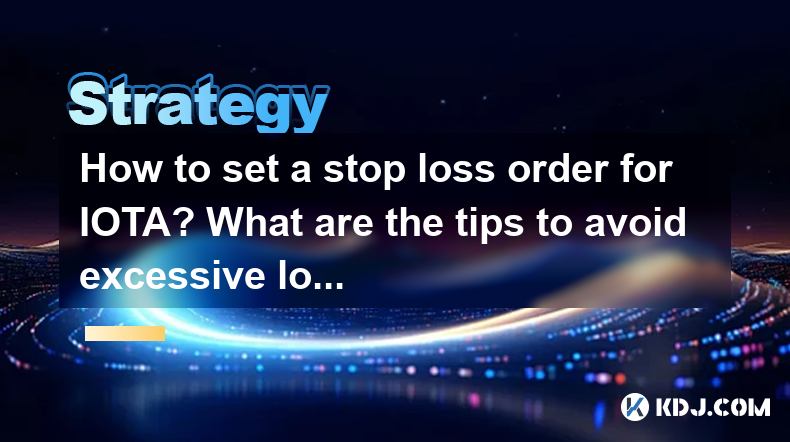-
 bitcoin
bitcoin $121833.232455 USD
-0.63% -
 ethereum
ethereum $4394.437030 USD
-2.00% -
 tether
tether $1.000570 USD
0.04% -
 bnb
bnb $1255.553465 USD
-3.73% -
 xrp
xrp $2.814944 USD
-1.59% -
 solana
solana $221.835346 USD
-2.40% -
 usd-coin
usd-coin $0.999869 USD
0.01% -
 dogecoin
dogecoin $0.249495 USD
-1.32% -
 tron
tron $0.336905 USD
-1.24% -
 cardano
cardano $0.816464 USD
-1.69% -
 chainlink
chainlink $22.130946 USD
-1.27% -
 hyperliquid
hyperliquid $44.208522 USD
-3.46% -
 ethena-usde
ethena-usde $1.000521 USD
0.02% -
 sui
sui $3.422897 USD
-2.51% -
 stellar
stellar $0.380164 USD
-1.31%
How to set a stop loss order for IOTA? What are the tips to avoid excessive losses?
Setting a stop loss order for IOTA on platforms like Binance, KuCoin, and Coinbase Pro is essential for managing risk and minimizing losses in the volatile crypto market.
May 04, 2025 at 03:22 am

Setting a stop loss order for IOTA is a crucial strategy to manage risk and protect your investments in the volatile cryptocurrency market. A stop loss order automatically sells your IOTA when its price reaches a predetermined level, helping you avoid excessive losses. In this article, we will explore how to set a stop loss order for IOTA on various platforms and provide tips to minimize your losses.
Understanding Stop Loss Orders
Before setting a stop loss order, it's important to understand how they work. A stop loss order is an order placed with a broker to buy or sell a security when it reaches a certain price. For IOTA, this means setting a price at which you want to sell your tokens if the market moves against your position. This can help you limit your losses and protect your investment.
Setting a Stop Loss Order on Binance
Binance is one of the most popular platforms for trading IOTA. Here's how you can set a stop loss order on Binance:
- Log into your Binance account and navigate to the IOTA trading page.
- Click on the 'Order' tab and select 'Stop-Limit'.
- Enter the 'Stop Price', which is the price at which you want the stop loss order to be triggered.
- Set the 'Limit Price', which is the price at which you want to sell your IOTA once the stop price is reached.
- Enter the amount of IOTA you want to sell.
- Review your order and click 'Place Order' to set your stop loss.
Setting a Stop Loss Order on KuCoin
KuCoin is another platform where you can trade IOTA and set stop loss orders. Follow these steps to set a stop loss order on KuCoin:
- Log into your KuCoin account and go to the IOTA trading page.
- Click on the 'Stop-Limit' order type.
- Set the 'Trigger Price', which is equivalent to the stop price on other platforms.
- Enter the 'Price', which is the limit price at which you want to sell your IOTA.
- Specify the 'Amount' of IOTA you want to sell.
- Review your order and click 'Place Order' to finalize your stop loss order.
Setting a Stop Loss Order on Coinbase Pro
Coinbase Pro also allows you to set stop loss orders for IOTA. Here's how to do it:
- Log into your Coinbase Pro account and navigate to the IOTA trading page.
- Click on the 'Stop' order type.
- Enter the 'Stop Price' at which you want the order to be triggered.
- Set the 'Limit Price' at which you want to sell your IOTA.
- Specify the 'Size' of the order, which is the amount of IOTA you want to sell.
- Review your order and click 'Place Order' to set your stop loss.
Tips to Avoid Excessive Losses
While setting a stop loss order is essential, there are additional strategies you can use to minimize your losses when trading IOTA.
- Determine Your Risk Tolerance: Before setting a stop loss order, assess your risk tolerance. Decide how much you are willing to lose on a single trade. This will help you set a stop loss that aligns with your investment strategy.
- Use Technical Analysis: Employ technical analysis to identify key support and resistance levels. Setting your stop loss just below a support level can help you avoid being stopped out by minor price fluctuations.
- Avoid Setting Stop Losses Too Tight: Setting a stop loss too close to the current market price can result in your order being triggered by normal market volatility. Allow for some breathing room to account for market fluctuations.
- Regularly Review and Adjust: The cryptocurrency market is highly volatile, and market conditions can change rapidly. Regularly review and adjust your stop loss orders to ensure they remain relevant to the current market environment.
- Consider Using Trailing Stops: A trailing stop is a type of stop loss order that moves with the market price. This can help you lock in profits while still protecting against significant losses. If IOTA's price increases, the trailing stop will move up with it, but if the price drops, the stop loss will remain at its highest point.
Common Mistakes to Avoid
When setting stop loss orders for IOTA, it's important to avoid common pitfalls that can lead to unnecessary losses.
- Ignoring Market Volatility: The cryptocurrency market can be highly volatile. Failing to account for this volatility when setting your stop loss can result in your order being triggered prematurely.
- Setting Arbitrary Stop Loss Levels: Setting stop loss levels without a clear strategy can lead to poor decision-making. Always base your stop loss levels on thorough analysis and your risk tolerance.
- Not Adjusting Stop Loss Orders: Failing to adjust your stop loss orders as the market moves can leave you vulnerable to larger losses. Regularly review and adjust your stop loss levels to reflect current market conditions.
- Over-reliance on Stop Loss Orders: While stop loss orders are a valuable tool, over-reliance on them can lead to missed opportunities. Use them as part of a broader risk management strategy, not as your sole means of protection.
Frequently Asked Questions
Q: Can I set a stop loss order for IOTA on mobile apps?A: Yes, many cryptocurrency exchanges offer mobile apps that allow you to set stop loss orders for IOTA. The process is similar to setting a stop loss order on the desktop version of the platform. You can log into the app, navigate to the IOTA trading page, and follow the steps outlined in this article to set your stop loss order.
Q: What happens if the market gaps and my stop loss order is not executed at my desired price?A: In the event of a market gap, where the price jumps from one level to another without trading at intermediate levels, your stop loss order may be executed at a price worse than your specified stop price. This is known as slippage. To mitigate this risk, you can use a stop-limit order, which allows you to set both a stop price and a limit price. However, be aware that if the market gaps beyond your limit price, your order may not be executed at all.
Q: Is it possible to set multiple stop loss orders for different portions of my IOTA holdings?A: Yes, you can set multiple stop loss orders for different portions of your IOTA holdings. This strategy, known as layered stop losses, allows you to manage risk more effectively by setting different stop loss levels for different portions of your investment. For example, you might set a tighter stop loss for a portion of your holdings to protect against short-term volatility and a wider stop loss for the rest to allow for longer-term price movements.
Q: How can I ensure my stop loss order is triggered during high volatility periods?A: During high volatility periods, ensuring your stop loss order is triggered can be challenging. One strategy is to set your stop loss at a more conservative level to account for increased volatility. Additionally, using a stop-market order instead of a stop-limit order can increase the likelihood of your order being executed, although it may result in slippage. Regularly monitoring market conditions and adjusting your stop loss orders accordingly can also help ensure they are triggered when needed.
Disclaimer:info@kdj.com
The information provided is not trading advice. kdj.com does not assume any responsibility for any investments made based on the information provided in this article. Cryptocurrencies are highly volatile and it is highly recommended that you invest with caution after thorough research!
If you believe that the content used on this website infringes your copyright, please contact us immediately (info@kdj.com) and we will delete it promptly.
- Chainlink, Reserve, LINK Price: Decoding the Signals
- 2025-10-10 10:45:14
- Meme Coins, ETFs, and Crypto Regulations: Navigating the Wild West of Digital Finance
- 2025-10-10 10:25:15
- HYPE, PENGU, and BlockDAG: Decoding Crypto's Latest Moves
- 2025-10-10 10:25:15
- Robinhood, Zora, and the Web3 Creator Revolution: A New York Minute on Tokenized Futures
- 2025-10-10 10:30:01
- Trump, Super Bowl, and Halftime: A Wild 2025 Ride
- 2025-10-10 10:30:01
- Cardano, XRP, and DeFi Integration: A Bombshell Development?
- 2025-10-10 08:25:17
Related knowledge

Practical parameter settings for a Bitcoin multi-timeframe moving average system
Sep 18,2025 at 10:54pm
Optimizing Timeframe Combinations for Bitcoin Trading1. Selecting appropriate timeframes is crucial when building a multi-timeframe moving average sys...

How can I filter out false breakouts in Dogecoin high-frequency trading?
Sep 22,2025 at 01:00am
Understanding False Breakouts in Dogecoin Trading1. A false breakout occurs when Dogecoin's price appears to move beyond a defined support or resistan...

Techniques for identifying tops and bottoms in the Bitcoin on-chain NVT model
Sep 20,2025 at 07:54pm
Understanding the NVT Model in Bitcoin Analysis1. The Network Value to Transactions (NVT) ratio is often described as the 'P/E ratio' of the cryptocur...

What does the surge in open interest in Bitcoincoin futures mean?
Sep 20,2025 at 11:18pm
Understanding the Surge in Dogecoin Futures Open Interest1. A surge in open interest within Dogecoin futures indicates a growing number of active cont...

How can I use the Ethereum USDT premium to gauge market sentiment?
Sep 18,2025 at 11:55pm
Understanding the Ethereum USDT Premium1. The Ethereum USDT premium refers to the price difference between USDT (Tether) traded on Ethereum-based plat...

What should I do if Ethereum staking yields decline?
Sep 20,2025 at 06:18am
Understanding the Causes Behind Declining Ethereum Staking Yields1. The Ethereum network transitioned to a proof-of-stake consensus mechanism with the...

Practical parameter settings for a Bitcoin multi-timeframe moving average system
Sep 18,2025 at 10:54pm
Optimizing Timeframe Combinations for Bitcoin Trading1. Selecting appropriate timeframes is crucial when building a multi-timeframe moving average sys...

How can I filter out false breakouts in Dogecoin high-frequency trading?
Sep 22,2025 at 01:00am
Understanding False Breakouts in Dogecoin Trading1. A false breakout occurs when Dogecoin's price appears to move beyond a defined support or resistan...

Techniques for identifying tops and bottoms in the Bitcoin on-chain NVT model
Sep 20,2025 at 07:54pm
Understanding the NVT Model in Bitcoin Analysis1. The Network Value to Transactions (NVT) ratio is often described as the 'P/E ratio' of the cryptocur...

What does the surge in open interest in Bitcoincoin futures mean?
Sep 20,2025 at 11:18pm
Understanding the Surge in Dogecoin Futures Open Interest1. A surge in open interest within Dogecoin futures indicates a growing number of active cont...

How can I use the Ethereum USDT premium to gauge market sentiment?
Sep 18,2025 at 11:55pm
Understanding the Ethereum USDT Premium1. The Ethereum USDT premium refers to the price difference between USDT (Tether) traded on Ethereum-based plat...

What should I do if Ethereum staking yields decline?
Sep 20,2025 at 06:18am
Understanding the Causes Behind Declining Ethereum Staking Yields1. The Ethereum network transitioned to a proof-of-stake consensus mechanism with the...
See all articles

























![Web3 Crypto Market Morning Report: Fomo on the Bnb chain continues, Binance launches the chain-sweeping platform Meme Rush, the market value of Xiuxian exceeds 40 million U.S. dollars, OK Binance business war begins [Vic TALK Issue 1437] Web3 Crypto Market Morning Report: Fomo on the Bnb chain continues, Binance launches the chain-sweeping platform Meme Rush, the market value of Xiuxian exceeds 40 million U.S. dollars, OK Binance business war begins [Vic TALK Issue 1437]](/uploads/2025/10/10/cryptocurrencies-news/videos/web-crypto-market-morning-report-fomo-bnb-chain-continues-binance-launches-chainsweeping-platform-meme-rush-market-xiuxian-exceeds-dollars-binance-business-war-vic-talk-issue/68e861c5dbd1c_image_500_375.webp)
















































